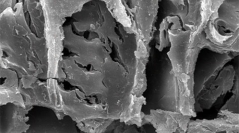

 Geodiversitas
26 (3) - Pages 391-401
Geodiversitas
26 (3) - Pages 391-401The anatomy of a coniferous wood, originating from a small trunk or a branch, from the Zechstein (Upper Permian) of NW-Hesse (Germany) is described. Though permineralized wood has been known from this locality at least since the end of the 18th century, this is the first specimen of trunk or branch wood described in anatomical detail from this locality. The wood has no visible growth-rings, rays are rare. Tracheids show uniseriate bordered pits of the “mixed” type, which are often contiguous and sometimes spaced more than one pit diameter apart. Cross-field pitting is probably araucarioid. It shows great similarities to the protopinacean form-genus Brachyoxylon Hollick & Jeffrey. However, due to the poor preservation of the cross-field pitting, a definite determination of this wood is not possible. Because of the lack of sterile foliage in organic connection, this specimen could not be assigned to any conifer taxon known from the Zechstein. The poor preservation of this specimen is probably due to desiccation, followed by mechanical stress during transport and microbiological decay. The latter process may have also played an important role for the permineralization of parts of this specimen with pyrite/chalcopyrite. Similar microbiological processes may have been involved during the permineralization of other plant material known from this locality (the so-called “Frankenberger-Kornähren”).
Upper Permian, Zechstein, permineralization, pyritization, wood anatomy, taphonomy